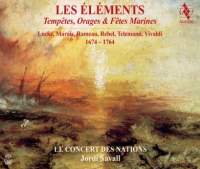Texte paru dans: / Appeared in: |
||||
|
Reviewer: Michael
De Sapio
If you were under the
impression that tone painting started with the Romantics, this pair of discs
(taken from a live performance at a music festival in Narbonne, France) will
prove you wrong. This program of musical “tempests, storms, and marine
festivals” from the 17th and early 18th centuries shows that composers of
that era were keenly interested in the pictorial capabilities of music and
its power to move and astound the listener by evoking the wonders of nature.
Rebel’s suite Les éléments, which opens the program, has the most copious
descriptive content. To depict “Le cahos” (chaos), Rebel starts off with a
dissonant tone cluster that seems to take us out of the Baroque and straight
into the era of Ives and Stravinsky. The music soon settles into
18th-century practice, though, and there follow imaginative movements
depicting water, air (complete with avian sounds), earth, and fire, along
with some typical French dances.
As for the rest of the
program, storm movements from operas by Marais and Rameau and especially
Locke’s incidental music from The Tempest are all of strong musical
interest. Less so Vivaldi’s “Tempesta di mare” Recorder Concerto, a tepid
piece which fails to sound much like its purported subject (a storm at sea),
and Telemann’s rather facile mythology-inspired Wassermusik suite; yet they
too help fill out our picture of program music in the Baroque.
Le Concert des Nations makes
an impressive showing at the start of the Rebel, with an intensely raw sound
in “Le cahos” and some fearless unison playing from the violins in the
furious figurations depicting “Le feu” (fire). With whooping natural brass
and slashing strings, even the non-programmatic Loure is made to sound
pictorial. But problems start to creep in with the Sicillienne, where the
slack ensemble seems to go beyond a mere interpretation of the “lazy” French
style. Locke’s Tempest music, with its eccentrically cranky lines and
convoluted textures (part of Locke’s distinctive personal idiom), gives rise
to some distressing ensemble problems. The evocative “Curtain Tune”—the only
programmatic movement in the suite, depicting a rising and subsiding sea
storm—sounds “at sea” indeed; one searches in vain for a clear pulse in the
slow parts. In the dances, lines seem to collide and crash; many movements
end with a type of exaggerated ritard that might be described as “stumbling
to the finishing line,” a clear sign of ensemble instability. All this is
puzzling, since Jordi Savall is listed as the director, and photos included
in the booklet show him conducting the ensemble; but at times Le Concert des
Nations sounds here like a conductorless group, one in which the various
sections of the orchestra are unable to hear each other well. Perhaps the
stage setup was to blame.
In addition to interpolated
tambourine in several of the dance movements—sometimes a bit
overenthusiastic, though mostly tasteful—we also hear intermittent
theatrical sound effects by a wind machine. This may well have been
effective in performance, but on a recording it soon becomes hokey and
tiresome. Recorded sound is good; the audience is quiet, and the only
applause that has been included is that at the very end. The audience also
seems to be participating in the final Rameau Tambourin, with some clapping
in rhythm! Finally, we may question the appropriateness of the ecological sermonette which Savall integrates into his program notes, an earnest attempt to tie Baroque nature music in with the modern “climate change” movement. Mixing politics with music is never a good thing; nor are the philosophical underpinnings of Savall’s preachments very apropos to a concert of period music. Would it ever have occurred to Rebel or Telemann—men of a Christian age with a Christian cosmology—to personalize the planet Earth to the extent of describing it as the “victim of aggression” whose “principal enemy is Man”? In sum, an exciting concept, but the end result is less than recommendable. | ||||
|
||||
|
|
|
|||
|
|
|
|||
|
Cliquez l'un ou l'autre
bouton pour découvrir bien d'autres critiques de CD |
||||




